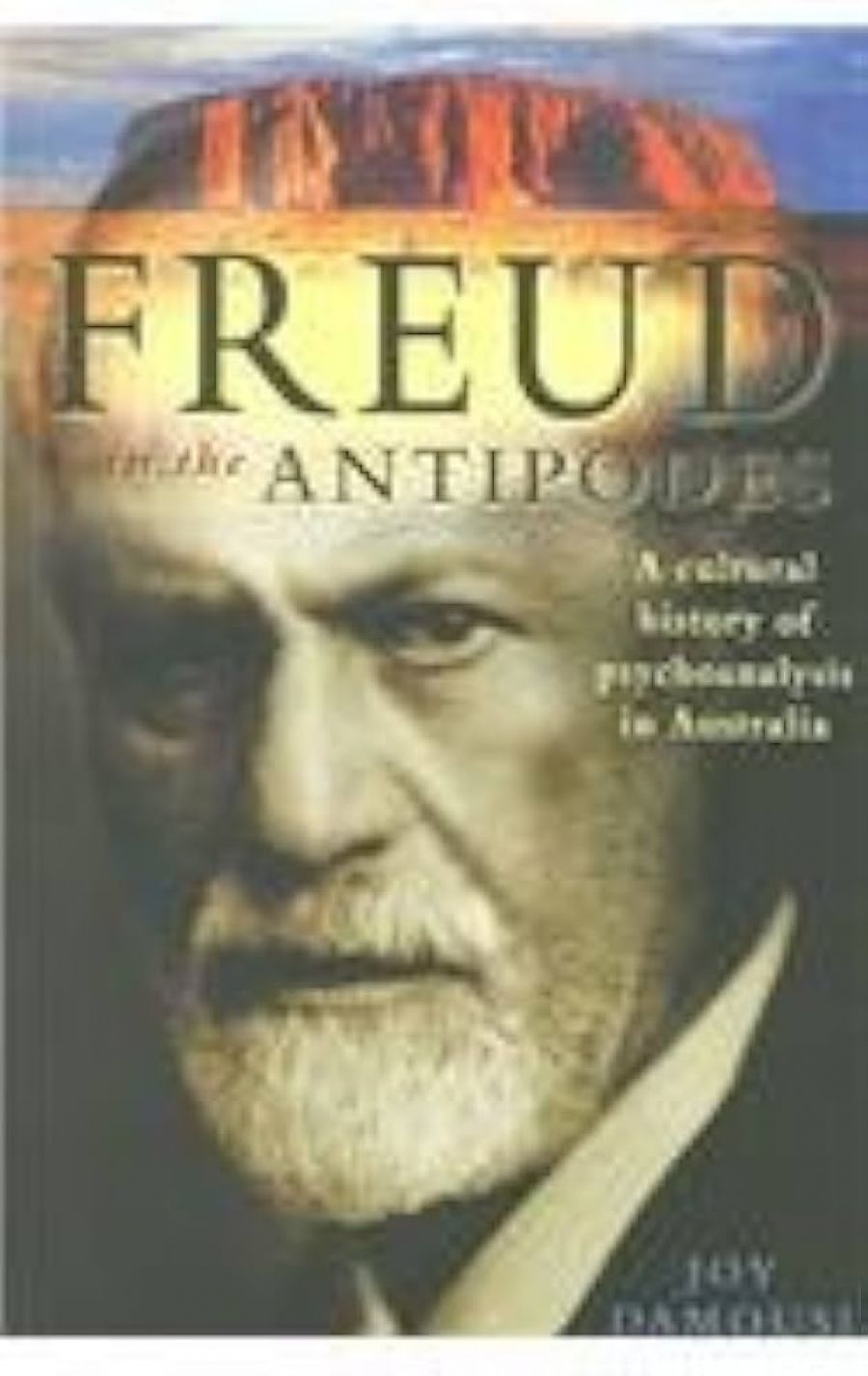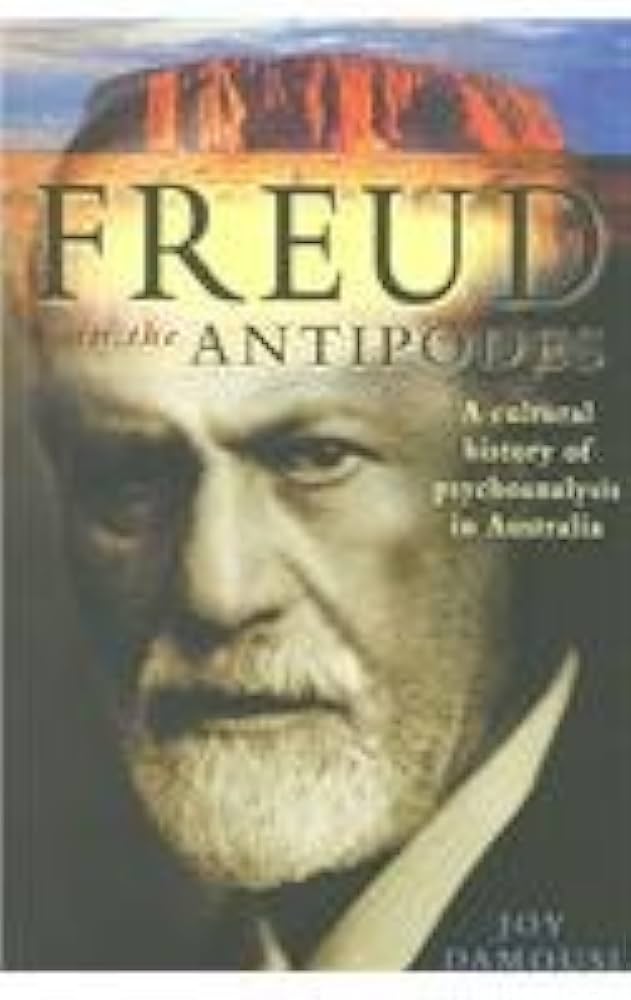
- Free Article: No
- Contents Category: Non-fiction
- Review Article: Yes
- Article Title: Freud with a crew cut
- Online Only: No
- Custom Highlight Text:
Freud in the antipodes? Who cares? Well, I for one am very pleased that Joy Damousi, a professor of history at the University of Melbourne, cares enough to have assembled this compendium of historical information about the influence of Sigmund Freud’s ideas in Australian circles over the past one hundred years.
- Book 1 Title: Freud in the Antipodes
- Book 1 Subtitle: A cultural history of psychoanalysis in Australia
- Book 1 Biblio: UNSW Press, $49.95 pb, 374 pp
- Book 1 Cover Small (400 x 600):

- Book 1 Cover (800 x 1200):

It is not widely known – and is not mentioned in this volume – that in an 1882 letter to his fiancée, Martha Bernays, Freud contemplated emigrating ‘to England or perhaps America ... or Australia’. I think it unlikely that the cultural and intellectual climate of Australia would have offered much nurture to psychoanalysis in the early 1900s, but Damousi documents that, despite our traditions of Aussie blokeishness and stereotypical unreflective hedonism, there have been, in Australia, highly significant ‘efforts to explore interiority through psychoanalytic frameworks’.
Let me express considerable admiration for the breadth of research evident in this book, but some regrets about a lack of depth in certain important respects. Damousi relies largely on interviews with contemporary figures and upon a staggering variety of published sources. As someone trained in psychiatry in Sydney in the late 1960s and early 1970s, and subsequently trained in psychoanalysis itself in the early 1980s, I have had the good fortune to have known, or known of, many of the significant individuals to whom she refers. For example, Professor John Cawte and Professor David Maddison, in Sydney – both strongly influenced by Freud’s concepts – served as role models for those of us young medical students and psychiatry trainees who were interested in listening to patients, rather than medicating them. Cawte could interview a patient in a ‘ward round’ setting, in front of up to twenty members of his hospital staff team and students, while the patient felt that only ‘the professor’ was in the room. Cawte’s quoted statements in Chapter 11, ‘In and out of the Asylums’, give an accurate feel of this impressive psychoanalytically informed psychiatrist and of his personal efforts to acquire necessary understanding of his own mind and that of his patients. But Damousi’s inclusion in this same chapter of several pages on the controversies over Freud’s views about homosexuality, together with a ‘conclusion’ to that very chapter dealing only with this latter issue, are puzzling.
Damousi states that, apart from Freud’s newly published ideas in the early 1900s, psychoanalysis came to Australia in three ‘waves’ of psychoanalysts: the first being the postwar Jewish immigrants (only a very few, sadly); a second group of ‘immigrants’, she says, ‘returning’ to Australia having sought training mainly in London; and a third ‘wave’ of refugees from Argentina (again, only a small number). The really significant group is the second, but Damousi does not do justice to their personal courage in leaving established careers – mostly in psychiatry – and seeking training (or further training) in a discipline that was hardly even respected ‘at home’ in order to better serve their future patients.
On the other hand, the sacrifices that are made, sometimes involuntarily and resentfully, by the families of those undertaking training are poignantly expressed through the voice of Dr Edith Phillips, whose husband Dr Albert Phillips helped establish the Melbourne Institute for Psychoanalysis.
The book is subtitled ‘A cultural history of psychoanalysis in Australia’. As Freud himself asserted, psychoanalysis is three related but distinct things: a body of theoretical concepts; a method of investigating the mind; and a method of treatment of psychological disorder. Damousi fails to keep these distinctions clear as she glides from one sense of psychoanalysis to another. The influence – or otherwise – of psychoanalysis on the academic and intellectual life of Australia is a very different issue from the need for psychoanalytic treatment of individuals suffering psychological pain – let alone its efficacy.
Damousi canvasses at length the important issues of medicating patients versus listening to them and attempting to understand them, and she allows a number of her interviewees to comment about issues to do with effectiveness of psychoanalytic treatment techniques. Although both are relevant and important, these issues cannot be done justice in a book such as this. In a chapter on ‘The Self and Society’, she devotes some space to the influence of these ‘new’ ideas on writing in women’s magazines and popular radio programmes.
This book’s main strength is in the detailing of the many individuals, from 1920 to 1970, who took up Freudian concepts and incorporated them into their professional work – and, in some cases, their personal lives. An example of this latter group is the philosopher John Anderson and his wife, who took Freud’s concepts of dream analysis very seriously in attempting to enhance their personal relationship. Art, literature and anthropology receive some attention, but it is the medical specialists who struggled to understand their patients rather than institutionalise or medicate them who receive the more detailed attention. Psychologists too, of course, struggled with the allegedly strange ideas of Freudian psychology.
Further, although Damousi alludes to serious conflicts surrounding issues as to who can call themselves psychoanalysts, she makes little or no distinction between individuals she readily labels ‘psychoanalysts’ with respect to the nature of their training and qualifications. While acknowledging the existence of several professional groups, she concentrates more on ‘political’ differences than on those based on the ‘authority’ of standards derived from organisations charged with maintaining training standards.
The more recent years are addressed through the interviews, which are notably (to me, at least) selective, when one considers who was and who was not interviewed – and of those who were apparently interviewed and not quoted. Some views are even quoted under a pseudonym, which must raise questions in an academic historical work. I do not think a fair representation of psychoanalysis’s current place in the antipodes emerges from the reporting of these interviews.
The book brought to mind reading Phyllis Grosskurth’s monumental biography of Melanie Klein (1986): a scholarly treatise on Kleinian psychoanalysis as well as a gossipy treasure trove of personal history concerning who felt what about whom. The present volume is not quite as scholarly or as gossipy, but it definitely contains both aspects.
For those readers who have some knowledge of psychoanalysis – either clinically or academically – there is much to be interested in and much to argue about. For the more general reader, there is much of interest, but little help in evaluating its relative significance in the broader scheme of intellectual ideas, let alone current clinical standing. Both groups of readers will probably be surprised at the extent to which Freud’s early ideas permeated a wide variety of aspects of daily cultural life in the far antipodean reaches, and what a range of well-known Australian figures in many walks of life grappled with their own inner conflicts in producing their particular contributions as grist for our cultural mill. Damousi, in her introduction, acknowledges that there are further challenges to be addressed in exploring the role of psychoanalysis in shaping our modern culture. She has contributed a great deal for future work to build upon.
Finally, I think the effective cover design deserves acknowledgment. It is a creative and economical combination of two iconic symbols: the well-known photograph of an elderly, bearded Freud and a classic representation of Uluru. Freud looks like a redhead with a crew cut.


Comments powered by CComment